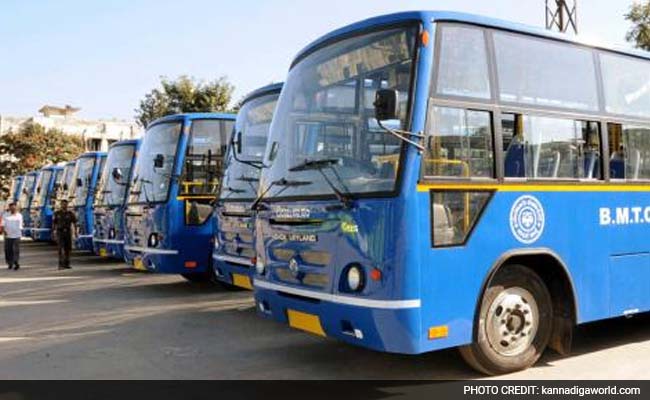
Karnataka is the most recent Indian state to make bus commutes free to women.
Chikamma travels half an hour every day from her home in a village on the outskirts of Bengaluru to work as a domestic helper in Yelahanka, close to the city’s airport.
For more than a decade, 39-year-old Chikamma, who only uses her first name, has taken the bus, which eats up a chunk of her Rs 20,000 ($240.45) monthly wages. Since the Karnataka state government made the public buses free to women in June, she has been able to save about 1,500 rupees a month.
“Earlier, I had money on some days, and on some days I didn’t,” Chikamma said. “Now, I am able to save up for household expenses and emergencies.” Her daughter’s ride to college is now also free.
Karnataka is the most recent Indian state to make bus commutes free to women, a program called Shakti, a Hindi word for strength. Delhi was the first, in 2019, to give out free, pink paper tickets to women. More than 1 billion have been used so far, the government said earlier this year. Punjab and Tamil Nadu also started similar schemes.
The policies aim to lift the number of women in the labor force by making it easier and less costly to work and travel. In India, it is still common for men to control women’s access to money; while the same men might object to women in their families working outside the home, no-cost transportation gives them an option they didn’t have before. Even if women are allowed to work, they often decide not to if their commute is unreliable or unaffordable.
“These policies suddenly open up new opportunities for women,” said Satya Arikutharam, a Bengaluru-based independent mobility expert.
India has one of the lowest rates of female labor participation in the world, according to the World Bank, with less than one-quarter of women above age 15 in employment as of 2022, down from 27% in 2012. In a 2014 report, the International Labour Organization attributed the falling rate to improved education attendance and increasing household incomes, meaning fewer women need to work, but also that women continue to have a lack of job opportunities, particularly as agricultural activity declines in India.
India is among those with the biggest barriers to female participation in the economy, according to a 2021 analysis by Bloomberg Economics. As of now, women contribute around 17% of India’s gross domestic product; closing the employment gap could expand India’s GDP more than 30% by 2050, it estimates.
Other states have implemented support for women short of free transit. In Maharashtra, where Mumbai is located, women pay half-price on buses. Uttar Pradesh, India’s most populous state, implemented a one-day free transit scheme for the Rakshabandhan festival this year. Rajasthan did the same on International Women’s Day.
“I would see it as an investment towards improving the mobility of women so that they participate, have access to opportunities, to education and jobs, and end up contributing to the economy and the society,” said Shreya Gadepalli, who leads the think tank Urban Works Institute in Chennai.
The policies have prompted a backlash from other transport providers. Private bus operators and auto-rickshaw and taxi drivers in Karnataka went on strike to oppose the Shakti scheme in July, about a month after it was announced, saying their earnings have suffered as a result. The ruling Bhartiya Janata Party, which is in opposition in the states with the policy, has criticized it for burdening public finances.
For women, free travel is also exacerbating the regular harassment they often face on public transport. A survey of 500 women in Delhi published by the nonprofit Greenpeace India in October found that 80% of respondents said buses didn’t stop for them, and more than half said they routinely faced humiliating remarks from male crew members and passengers for taking the bus for free. Aakiz Farooq, one of the report’s authors, said that male riders often refuse to give up their seats even in the female-only sections.
“It is understood you will face sexual harassment once a day” on the bus, said Shweta, a 25-year-old student at Jamia Milia Islamia University in New Delhi who only uses her first name. “If I say anything to them, they’ll say, ‘If you have a problem, take auto,'” referring to auto rickshaws.
So far, governments that have implemented the scheme say it’s been a success and hope to expand it. Women made up more than half the riders on Karnataka’s buses since the Shakti scheme began in June, data from its transport department show. The state also asked for 5,600 more buses to be added to its fleet to meet the growing demand. Delhi’s government in 2020 said that it hopes to give women free access to its metro rail in the future.
Free transit schemes for women also open up opportunities for women in more than just economic ways, allowing them to travel for leisure too, said Pawan Mulukutla, who runs an integrated transport, clean air and hydrogen program at the nonprofit World Resources Institute India.
For Shweta, direct bus routes not only take her from home to university and her previous workplace in the satellite city of Noida, but also to Delhi landmarks such as the Red Fort, the Qutub Minar and the Sarojini flea market.
“We don’t have to depend on anyone now,” she said. “I’ve seen the entirety of Delhi using the bus.”




